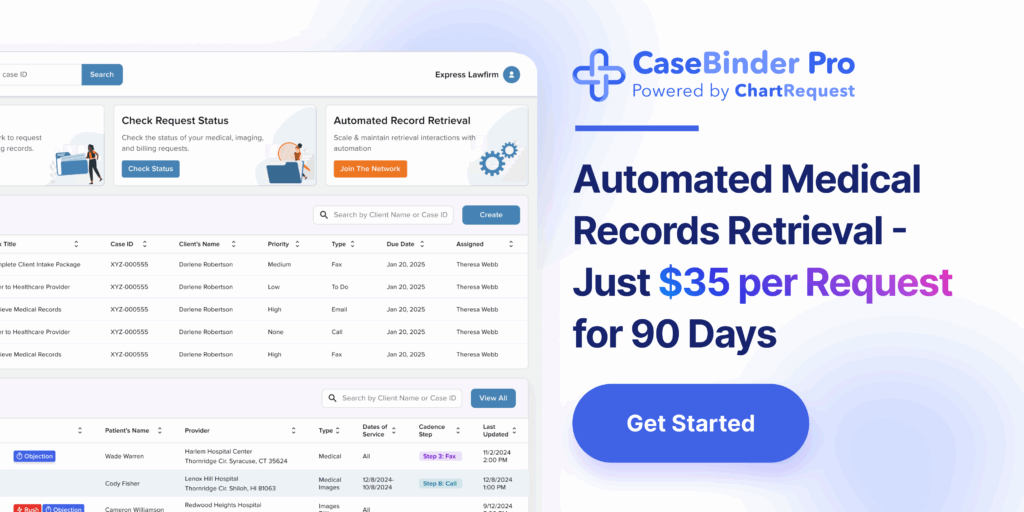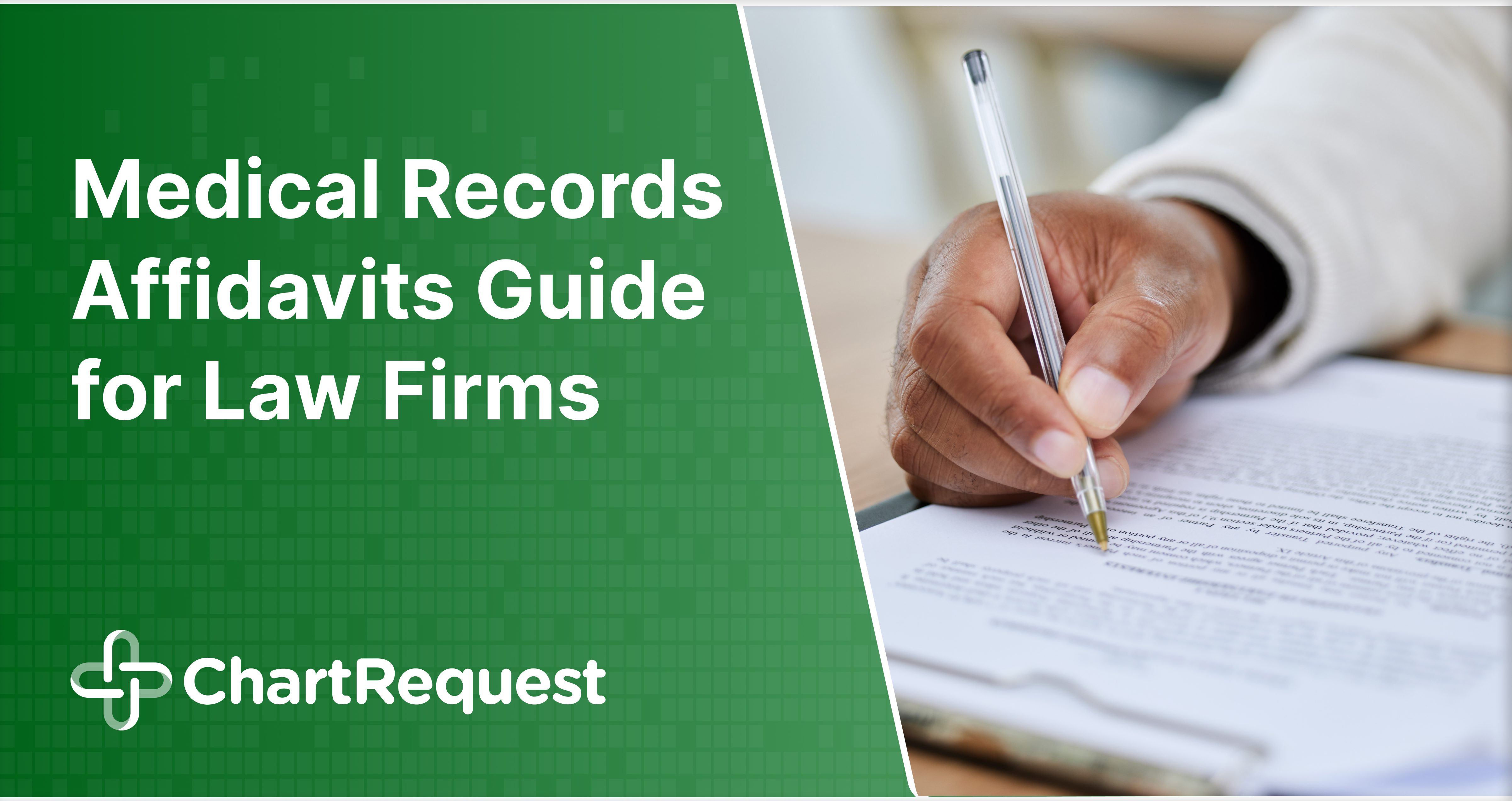In cases involving medical evidence, timely access to admissible medical records can directly influence legal outcomes. A medical records affidavit certifies the authenticity of those records, allowing attorneys to introduce them as evidence without requiring testimony from a healthcare provider.
For law firms handling litigation or insurance claims, knowing how to request and validate these affidavits and certifications is essential.

What Is a Medical Records Affidavit?
A medical records affidavit, sometimes called an affidavit of medical records, is a sworn statement from a healthcare provider or custodian of records. It verifies that the attached records are accurate and complete to prevent falsified medical records from impacting a case.
Law firms routinely use affidavits in personal injury claims, malpractice suits, insurance disputes, criminal proceedings, and disability cases. They help ensure the admissibility of medical records without requiring a live witness.
Legal Requirements for Valid Medical Records Affidavits
For a medical records affidavit to hold up in court, it must do more than accompany the records: it must also establish their legal reliability.
A valid affidavit typically includes:
- A declaration that the attached records are true and complete copies of the originals maintained by the provider
- An assertion that the records were created and kept in the regular course of business
- A clear description of the records’ scope—typically identifying the patient’s name, date range, and type of records provided
- A signature from the custodian of records, along with either notarization or a sworn statement that complies with the jurisdiction’s evidentiary rules
These elements are crucial for admitting medical evidence without requiring live testimony. They satisfy hearsay exceptions under federal standards such as:
Federal Rule of Evidence 803(6): This rule provides an exception to the hearsay rule for records of regularly conducted activity, allowing business records to be admissible if they meet certain criteria.
Federal Rule of Evidence 902(11): This rule allows for the self-authentication of certified domestic records of regularly conducted activity, eliminating the need for a live witness to establish authenticity.
However, states often impose additional conditions. Because these standards vary, matching your request language to the court’s jurisdiction is essential.
Common Challenges Law Firms Face
Even firms with well-established workflows often encounter unnecessary setbacks when requesting certified medical records. The challenge usually lies not in legal process gaps, but in provider-side limitations.
Affidavits returned late, incomplete, or formatted in a way that will not satisfy evidentiary rules can create significant obstacles during discovery, pre-trial motions, or hearings.
The most common issues include:
- Missing or incomplete signatures. Affidavits may be unsigned, missing the notary seal, or lacking a valid custodial declaration.
- Improper scope or incorrect patient identifiers. Records may cover the wrong date range, omit key documentation, or reference the wrong individual.
- Noncompliant affidavit language. Many providers use generic forms that fail to align with jurisdictional requirements.
- Unreliable file formatting. Documents may arrive as handwritten notes or low-quality scans, making them difficult to authenticate.
- Lack of verifiable chain of custody. Without a compliant affidavit and audit trail, the origin and handling of the records may be called into question.
For litigation teams, these issues are more than administrative annoyances. Missing or flawed affidavits can cause objections to otherwise relevant information. In high-volume firms, they also result in measurable operational inefficiencies.
How to Properly Request a Medical Records Affidavit
Improving the way affidavits are requested can reduce delays and ensure compliance. Use clear, jurisdiction-specific language when preparing subpoenas or formal requests. Be specific about the need for a notarized affidavit, and where possible, include template language that meets local rules.
If sending a manual request, address it to someone authorized to certify records. This typically includes the Health Information Management (HIM) director, Medical Records Supervisor, or a Compliance Officer. In smaller practices, the Office Manager may be the best contact. If unsure, call and ask who handles medical record or subpoena requests.
Submit requests as early as possible and review the returned affidavit to confirm that all required elements are present. Services like CaseBinder help law firms get medical records fast without manual follow-up.
What if an Affidavit Is Rejected?
Affidavits may be rejected for issues like missing notarization, incorrect language, or incomplete record scope. If this happens:
- Clarify the issue. Contact the court clerk, opposing counsel, or your compliance team to understand what’s missing.
- Request a corrected version. Reach out to the provider with specific guidance and any applicable jurisdictional rules.
- Escalate if necessary. If the provider is unresponsive or unwilling to comply, send a follow-up subpoena or escalate to a supervising contact.
Pro tip: Keep a log of affidavit requests and responses. A clear paper trail supports motions and helps justify reasonable delays if challenged.
How ChartRequest Simplifies Medical Record Certification
ChartRequest helps streamline the affidavit process through a secure, centralized platform. Our system automatically tracks medical record requests and enables attorneys to request medical record certification as part of the request process.
A common cause of delay is the provider’s inability to access a notary in a timely manner. ChartRequestPlus Digital Notary resolves this by enabling providers to complete notarizations within the same platform they use to process records.
To learn more about how ChartRequest supports secure, compliant medical record certification, create an account today.


